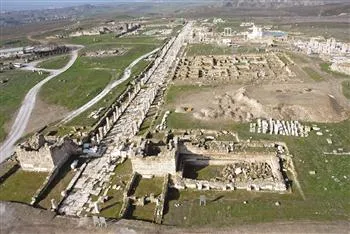Archaeologists working at Laodicea, which is home to one of the world’s oldest churches, are hoping to convert the ancient city in the Aegean province of Denizli into an archaeological park by unearthing ruins similar to Ephesus.

Laodicea is an important center for Christianity and it includes the seventh oldest church in the world, said Şimşek.
The team’s ultimate aim is to finish the all the excavation by 2015 and make the ancient city another Ephesus. “We believe it will attract 2 million visitors a year.”
The past nine years of the excavation have revealed 3,050 ancient artifacts in the city. Among the most important finds are the heads of sculptures of Augustus, Dionysus, and Aphrodite and a sculpture of Zeus. The ancient city also has a sculpture of Hera and emperors.
This year, the first phase of the excavation took four months followed by a second phase that took six months. “We will continue the excavations for 12 months. The restoration and excavation work are done together at Laodicea,” said Şimşek. “This system makes the excavation more active. There are exclusive restoration teams who take care of the remains that are unearthed. The excavation work helps us to discover ties between today and the ancient times.”
Şimşek said excavations revealed a rooster, the symbol of Denizli, and remnants of pomegranates and eggplants.
One of the top priorities of the excavation is to discover signs of textile workshops, dye workshops and pieces of fabrics, said Şimşek. “All of these remains also lead us to Denizli’s cultural heritage, which is still very present today. Denizli is the center of textile.”
Much of what has already been excavated has undergone restoration. Doors and tours from eastern Byzantium and fountains have been restored. A large house of 2,000 square meters and a street east of the dig has also been restored.
Excavations have also revealed temples, a Greek Agora, and pieces of an ancient bath have. The finds are in line for restoration as well, said Şimşek.
Ancient city plans
Şimşek said Laodicea’s city plan might have inspired today’s architects and city planners. “The architecture of social, religious and other buildings in the ancient city was all part of a specific system.”
Archaeologists have found that the main street of Laodicea includes shops, he said. Just outside the city, archaeologists have found large burial grounds with tombs spread throughout.
“All these finds show that the city was made with a great plan and its infrastructure was very good,” Şimşek said.
Şimşek also said the excavation of the Laodicea could contribute to shedding more light on world heritage. “We aim to leave this place to the next generation.”
Source: Hurriyet Daily News [December 08, 2011]